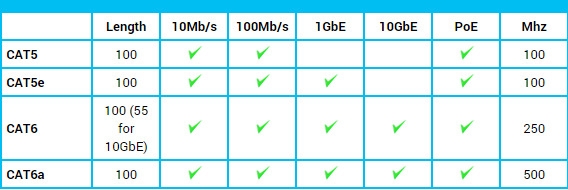

The reason why copper cables are twisted as pairs, is because the twisting of two wires would help contain the electromagnetic field that would be created as a result of electrical signals passing through the wires. Choosing the right HDMI Cables, HDMI over Ethernet, HDMI over Network UTP/STP Bandwidth Required.What is HDBASET Technology and HDBASET V2.0 / V2.1 Technology.OVHD, DSTV Explora Installation Diagram / Sample Distribution diagram to multiple displays.Optic Fiber Cables – Difference between UPC vs APC, Single Mode vs MultiMode and SFP Compatibility.HDMI v2.1 Specifications including HDMI v2.0, HDMI v1.4 and older.HDMI Best Practices Installation Guidelines and Recommendations.HDCP Error / HDMI Handshake (Picture Sync) Troubleshooting and Guidelines.

Ethernet Networking Cable : CAT5 vs Cat6 vs Cat7 vs Cat8 : What is the Difference ? Wiring and Specifications.DSTV XtraView Installation & Frequencies (DSTV User Bands) for Multichoice Explora/HDPVR and other decoders.Home Entertainment Wiring Diagram – HDMI to AV, HDMI Splitter, HDMI Extender, HDMI to VGA, VGA to HDMI.2.4Ghz vs 5Ghz Wifi Bands & Wifi 4 vs Wifi 5 vs Wifi 6 Technologies.Technical Info | Wiring Diagrams Menu Toggle.While Cat 6 is expected to supersede both Cat 5 and Cat 5e cabling in the future, all three types of cables continue to be popular for use in network installations. In addition to its support for higher performance than the Cat 5 specification, the Cat 6 standard also includes more stringent specifications for crosstalk and system noise.

Cat 6 is backward compatible with the Cat 3, Cat 5 and Cat 5e cable standards, and as with Cat 5 and Cat 5e cabling, Cat 6 cables consist of four unshielded twisted pairs (UTP) of copper wire terminated by RJ45 connectors. The Cat 6 standard was first released in 2002 as part of the Telecommunications Industry Association s TIA/EIA-568-B.2-1 document specification. The Cat 6 standard provides performance of up to 250 MHz (500 MHz for the newer Cat 6a standard) and can be used up to a maximum length of 100 meters (55 meters for 10GBASE-T networks). Short for Category 6, Cat-6 network cabling is used as the cabling infrastructure for 10BASE-T ( Ethernet), 100BASE-TX (Fast Ethernet), 1000BASE-T ( Gigabit Ethernet, or GbE) and 10GBASE-T ( 10-Gigabit Ethernet, or 10 GbE) networks.


 0 kommentar(er)
0 kommentar(er)
